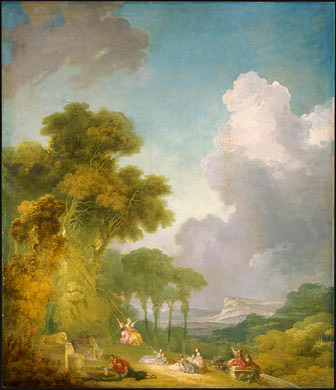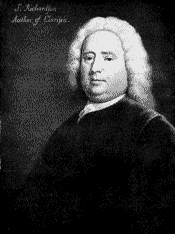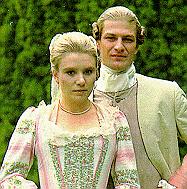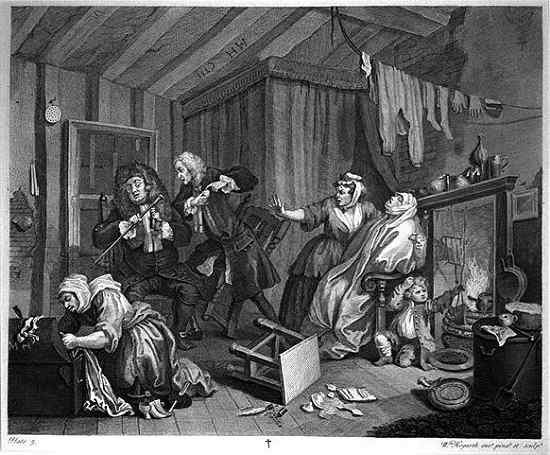PREVIEW

Jean-Honoré Fragonard
French, 1732 - 1806
The Swing, probably c. 1765

The Epistolary Novel:
The term epistolary describes novels that are written as an exchange
of letters. Samuel Richardson started this trend with his
Pamela
(1741) and Clarissa (1748). Soon it was imitated all over Europe.
You will notice that Frankenstein is an epistolary novel.
The epistolary novel
emphasizes two important qualities in emerging fiction - first, an
intimacy between the reader and the novelist and second, the ability of
the writer to locate a point of view.
One of the most interesting and readable of the letter-exchange novels
was also one of the first and best mystery stories -
Wilkie Collins's
'The Moonstone' (1868). Bram Stoker's masterpiece of horror
'Dracula' (1897) also was written in the form of letters and journals.
The decline of letter writing in the 20th century resulted in a decline of
this kind of novel.
Pamela and
Clarissa Harlowe (Clarissa
site about the BBC Production)

Samuel Richardson's Pamela, 1740–41, was parodied by Henry Fielding in
An Apology for the Life of Mrs
Shamela Andrews (1741) and Joseph Andrews (1742).
Richardson began his career in 1706 as an apprentice printer in London, and later came to write fiction. His
Pamela; or, Virtue Rewarded (1741), an epistolary novel, is held by many to make him the originator of the English novel. His
Clarissa (1748), one of the longest novels in the English language (and also epistolary in form), recounts the rake Lovelace's seduction of
Clarissa Harlowe and her eventual death.

Samuel Richardson was apprenticed as a printer at a
young age. He was very successful at this, and his most successful
venture as a printer was his own creation of a book that outlined
etiquette for young women. Hoping to follow up on this success, he
began a little self-help book to show young women of indeterminate class
how to write letters home to their families when they went into
service.
According to the accounts, he began the project by
simply illustrating how a young woman would properly address the issues
she would be expected to confront as a servant in a great house. So,
we first get the very tame letters to her father where she is quite
properly describing the mansion, the grounds, the other servants, and,
most important, her own humble attitude toward her job!!
Then, it appears, he somehow got caught up in the
drama when Mr. B. appears on the scene. Now we have a dicey
situation, because Mr. B. (notice that these folks are not titled
nobility, rather they are members of the rich merchant class, even though
Lady B. seems to have claim to a title of sorts.)
Anyway, the fun begins as Mr. B. determines that he
is going to have Pamela for himself, without marriage (since she is a rank
commoner, a peasant) - and Pamela, Virtue Enshrined - spends the next 800
pages (yes!) resisting, outwitting, fainting, crying, and continuing to write,
yes, the whole bloody story!!
Thomas Hogarth, a famous painter and engraver of the
time, captured many of the plots of these mid-century novels in sequences
of paintings or engravings - one of them is called "The Harlot's
Progress" and another called "The Rake's Progress."
Clarissa is the harlot, and Lovelace, for the most part, the Rake.
there is a fine site with all of Hogarth's work for
you to look at : Hogarth
Virginity figures very big in these stories - much
more than one would think, given what we know about the developments of
the new world. But, in real life, sometimes societies hold on for
dear life to concepts that no longer have as much consequence as they
might, at one time, have had . . . .



One of the reasons for the high anxiety about marriage and virginity
in the 18th Century was the legal situation--and the social privilege of
the elite.
18th Century Legalities: Marriage
By Beth Bernard
William Hogarth, an English painter and engraver who satirized the moral follies of his age completed Marriage a la Mode in 1743. His "exuberant satire of marriage for money, his pungent details of upper-class life, and his mastery of complex scenes" exemplify the strain between new and traditional social philosophies.
Historically, the roles of men and women within marriages have reflected their roles within society. Laws and customs have traditionally restricted women's opportunities, limited their legal rights, and required them to be under the protection and control of a man. For example, under the legal doctrine of couverture, developed in England during the Middle Ages, the law viewed the husband and wife as one person, the husband. As a result of couverture, a married woman lost many of the legal rights she may have possessed before marriage. For example, a single woman who owned property before wedlock, she lost her rights over that property upon marriage. It was expected that a bride's wealth would became her husband's. Clarissa, the heiress of her Grandfather's estate, was obliged under law to submit all of her property to Lovelace upon marriage.
Traditionally, a woman's loss of her maiden name after marriage signified that her identity was absorbed by that of her husband. It also signified her subordination to him.
A wife was legally obliged to live wherever her husband chose, as well as submit to her husband's sexual demands. In return, the husband was financially responsible for the family and had the right to control and physically discipline the wife.
The period 1680 - 1710 was one of acute crisis in many propertied families. The clash between the conflicting ideals of patriarchy and individualism in the choice of spouse reached an acute stage at this time.
Early in the 1730's there were three bitterly contested and very expensive contract cases. All three were cases of women who gave birth as a result of sexual relations with a marriage suitor, entered into on the basis of an alleged contract which was later repudiated. Courts were overwhelmed with women who had been seduced and impregnated on promise of what proved to be unenforceable contracts, as Lovelace implied in his description of the marriage contract for himself and Clarissa. In 1753 Parliament passed "An Act for the Better Preventing of Clandestine marriages," better known as "Lord Harwicke's marriage act" in honor of the formidable Lord Chancellor who was responsible for its legislation. Parliament passed Lord Harwicke's marriage act which stated that no marriage was valid unless the banns were clearly published in church or an Episcopal license obtained; the parties being married had to indicate in writing their true names and addresses and if they were aged under twenty-one they needed the consent of their parents or guardians.
Ecclesiastical courts were ineffective in controlling the burgeoning number of weddings performed at short notice by unscrupulous priests who were willing, for a fee, to ignore the protocols of bans or license or the question of parental consent. So-called "lawless churches" in London ran a notorious trade in clandestine marriages. The issue that concerned the elite of clandestine marriages, and which brought the issue before Parliament, was the marriage of runaway heiresses to unsuitable lovers.
Furthermore, a new system of registration was begun that recorded the names and signatures, or marks, of those married, as well as the date of the event, their parishes of abode, and the names of the minister and two witnesses. Ministers who ignored these provisions were charged as felons and transported to America. Anyone who falsified a marriage license or tampered with the register book was subject to penalty of death. Samuel Richardson's novel 'Clarissa' reflects controversies over marriage in England that led to the passage of the Marriage Act in 1753, enacted five years after the novel was published. Although Richardson supported the act's requirement of parental consent in the marriage of anyone under the age of 21, the characters in Clarissa exhibit contradictory opinions of parental authority. Richardson's exploration of this subject influenced readers to oppose the Marriage Act.
18th Century Legalities: Rape
By Shauna Brooks
1. Punishment for rape- Challenged to a duel with a family member of the victim.
If it went to trial, punishment could be either death or acquittal.
2. Trials-
"The Trial of John Motherill, for a Rape"-Catherine Wade was walking on a street said to be walked on by "loose women" when she was attacked by John Motherill and raped. His main defense was that he though she was a loose woman and therefore it would have been okay. The jury, after asking if there were any other options besides death or acquittal, found Motherill not guilty.
"The Trial of Lord Baltimore, for a Rape"-Sarah Woodcock was tricked by a woman into entering Lord
Baltimore's house. Once there, she was held against her will by two woman and Lord Baltimore, and after a few days, was raped by Lord Baltimore. A few days later, she saw some people she knew, but for fear of being hurt,
didn't say anything had happened and said that she was at Lord Baltimore's voluntarily. She finally got away, and when the case went to trial, Lord Baltimore was also found not guilty, most likely because the jury thought Sarah Woodcock was in his house and with him voluntarily. This trial sounds pretty similar to Clarissa, since the girl was held against her will, and went along with the stories of being with the man willingly. This shows that had Clarissa brought charges against Lovelace, he probably would have been acquitted since so many people had seen her and known her as Mrs. Lovelace.
3. How women are viewed- They are viewed as ruined, robbed of virtue, impure, "although innocent, will never more be considered as immaculate.", (Motherill trial) They were basically ruined for the rest of their lives, unfit to be
anybody's wife.
4. What happened to Clarissa- Went somewhat insane temporarily, either due to the drugs or the rape.
Got herself together, and since she is so noble and good, she forgave everybody, including Lovelace. Her only wish was to be able to go quickly to Heaven, where she would be rewarded for being so good.
5. What happened to Lovelace- For a while, he still
didn't see raping her as being that wrong. He blamed other women for claiming their virtue was important to them, and then giving into him. He figured Clarissa would eventually forgive him, and he would marry her, so she
wouldn't be viewed as ruined, and everything would be okay.
After a while, he started really regretting what he had done, but not because he felt bad; mostly because she seemed crazy and he was afraid she had lost her intellect and he
wouldn't like
her as much. Only when she dies does he realize how wrong he was, and feels bad for ruining her. He finally realizes that she really was as pure and good and noble as she acted.
18th Century Legalities: Inheritance
By Leanne de la Torre
--There were major discrepancies between common law and actual practice regarding inheritance.
Common law:
1. Land goes to oldest son.
2. If no sons, land goes to daughters, divided equally; preference over collateral males.
However, realistically, this was not the case. Eileen Spring suggests that statistically 42% of women would be heiresses, either directly or through collateral inheritance, by common law. Yet, between 1540 and 1780 only 5% of inheritances went to daughters and 8% to collateral females-what was biologically unavoidable (16).
Reasons are feudal customs, attitudes about men and women in continuing blood lines and the passage of titles.
--Statute of Wills 1540:
Allows men, not married women, to write wills concerning real property.
--Inheritance and Property in Clarissa:
While land normally went to the oldest son or male relative, "by intestacy, and by individual affection or perversity, it could be equally divided among daughters" (Trumbach 41). Such is the situation in Clarissa; affection has made her an heiress.
Introduction: p. 20-21
p. 53: Preamble to the clauses in her grandfather's will Swan points out that Clarissa's status as an heiress "dramatizes the financial and affective problems faced even by privileged women" (81). Clarissa feels bound by duty to her family and her father, at least in some areas. Being under twenty one she needs a male trustee. Still, her estate is lawfully hers and Anna in Letter 183 even tells Clarissa to "resolve to assert your right. Claim your own, and go and live upon it as you ought" (587). Clarissa is actually inhibited by religious/moral issues, rather than legal ones.
p. 76: Letter13, Clarissa to Anna Howe
- In this letter Clarissa gives some background concerning her siblings' jealousy, her grandfather's will, and her family's excitement toward Solmes.
p. 596: Letter 186, Lovelace's marriage proposal
Eighteenth century readers would have recognized the generosity in his proposal; "He is offering to give up legal rights to her property, which would become his by law on marriage"
(Shaw 79).
p. 664: Letter 206, Lord M. to Lovelace
"Pray let her know, I will present HER (not you) either my Lancashire seat or the Lawn in Hertfordshire." Lovelace had mentioned this possibility in his proposal, and it is certainly legal
with consent of relative, usually a father, but in this case, uncle.
The
Gothic Ladies
Some
might observe that the subject matter of these early novels is rather
dark. Dark indeed. But, if we weren't getting the rape of some
innocent woman, we were in another dark wood, provided by the wonderful,
and prolific, "gothic" women writers of the later 18th Century.
Fanney
Burney
Rather than stressing the influence of positive role models on her heroine Evelina as she enters fashionable society, Frances
Burney foregrounds the words and actions of rude, insolent, insincere, and false role models so that Evelina can learn how not
to be a young lady, worthy of respect, admiration, and the hand of a nobleman. This strategy of characterization allows the
positive characters to remain exemplars, but does not force them to appear too uppity or snobbish. All of this is not to say that
these positive characters are wholly silent; indeed, Lord Orville, Reverend Villars, and Mrs. Villars are all quite vocal and play
major parts in Evelina's letters, or, as in the case of Reverend Villars, are present because they too write letters. However, there
is one positive character who is noticeably silent: Maria Mirvan is barely heard in the novel as a speaking subject, either in
Evelina's letters or her own. Maria's silence in the novel seems strange given Evelina's portrayal of her relationship with Maria as
best friends since childhood: Evelina even goes so far as to say that Maria is her "second self." But what kind of self is Maria for
Evelina? At the end of the novel, after she has been engaged to Lord Orville, Evelina's self-narration is subsumed under the
narration of other people's words and actions. Maria's silence, coupled with her actions as informant, obeyer, and receiver,
serves to quietly instruct Evelina on how to become a respectable young woman, one who must give up any claims to
self-representation--and consequently an individual identity--in deference to the wishes and needs of others.
As literary foremothers, Frances Burney and Mary Wollstonecraft worked toward greater acceptance of female authorship and
the improvement of literature in general: Burney showed that even a young girl could and should write with Evelina, while in her
non-fiction and fiction, including Maria, Wollstonecraft consistently strove to highlight and improve the plight of women under
patriarchal rule. Though these women provided real-life examples as literary mothers to subsequent generations of female
authors, in their own work they found difficulty in presenting real-life maternal role models. Perhaps because of their own
strained place within a mother-daughter relationship or because of the socially-prescribed distance between mother and
daughter, it is nonetheless the case that in Evelina and Maria the figure of the mother is completely separated from the daughter.
Indeed, not only is the mother separated from the daughter, but she is also separated from humanity, to the point that she is only
represented as textual. That is, the mothers in these novels are not physically present--they do no actual work as mothers--but
instead are present only through their words. It is only in this textual way that these mothers can influence or affect their
daughters, which adversely affects their daughters and, particularly in the case of Maria, themselves. Therefore, it seems as if
these literary foremothers displaced the figure of the mother onto the page in order to show how detrimental the separation of
mother from daughter can be to women and, perhaps, to the entire social structure.
Another group of forerunners of Romanticism included the writers
of stories of terror and imagination --the Gothic school of "spine
chillers."
Representative novels are 'The Castle of Otranto' (1764), by
Horace Walpole (1717-97); 'The Mysteries of Udolpho' (1794), by
Ann Radcliffe (1764-1823); and 'The Monk' (1796), by Matthew
Gregory Lewis (1775-1818). All these novels are filled with the
machinery of sensationalism--unreal characters, supernatural events,
and overripe imagination. These qualities reached a fever pitch in
'Frankenstein' (1818), by Mary Wollstonecraft Shelley (1797-1851).
The
Legacy
By
the end of the 18th Century, women were writing, although without much
appreciation from the "critics." They had, however,
established a wide popular audience, mainly women. The
"gothic" novels by writers like Ann Radcliffe were the natural
evolution of the Romances of the earlier centuries - but there was
something else coming onto the scene. In the Women and the New World
lecture, we spoke briefly
(and there was more information
in your web
lecture notes) about the growth of scientific interest as a result of new
doubts about the closed system universe. These two threads came
together somewhat in the writing of Mary Wollstonecraft, and, of course,
gave rise to a literary masterpiece with Frankenstein.
Next week, we will explore the gothic strain of work (still very much
alive today), the increasingly important writing on women's rights that
arouse around the French Enlightenment and the revolutions in America and
France (remember, by 1820, all of the colonies would have revolted) - and
the ideas that began to arise as the world began to mechanize.






